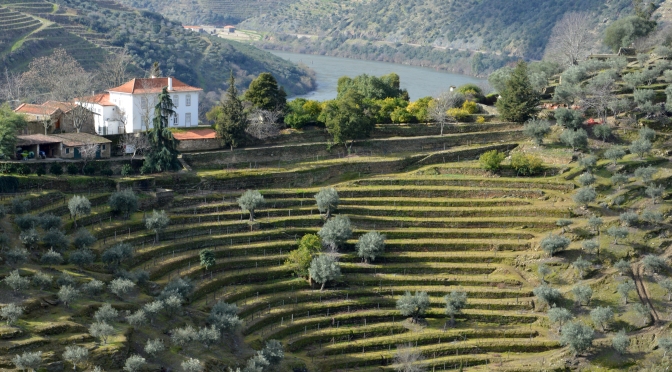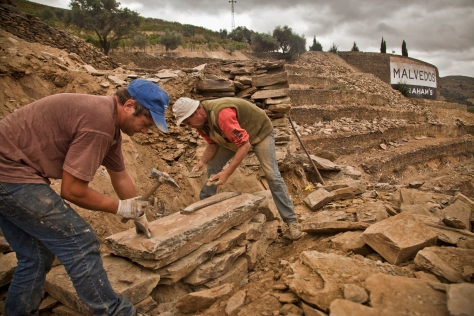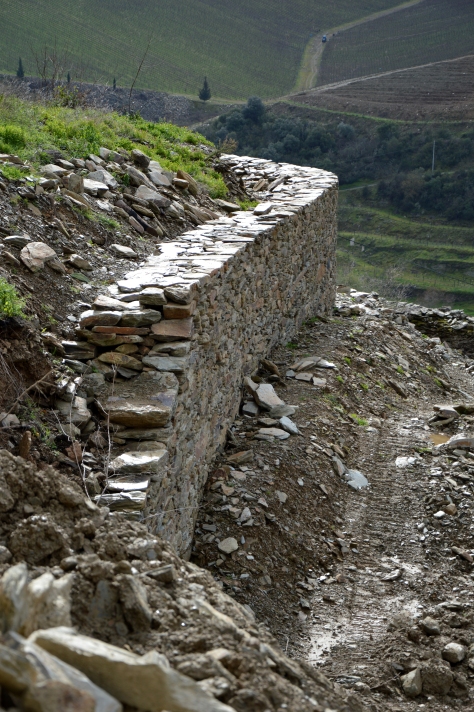The tranquility of the winter landscape at Quinta dos Malvedos is broken only by the sound of the rushing torrent of the Síbio stream, swollen by January’s 133mm of rainfall — well above the monthly average of 78.7mm for this area. The Síbio divides in two the 18th century stone terraces at Malvedos known as ‘Port Arthur’, sections of which are still being restored, and in parts rebuilt, by a seven strong team of skilled Douro stonemasons who specialize in repairing dry stone vineyard terrace walls (see Tracking the Season – 28th November 2013).
These artisans’ work is not easy, combining as it does substantial physical exertion with deft movements as the men manoeuvre schist rocks of various shapes and sizes, constantly calculating where the best fit is to be found, coaxing them into position with just their hands, aided by all manner of hammers, picks and mallets. This activity is no different to when the original vineyard terrace walls were built in the Douro over three centuries ago. The only concession to the twenty-first century is the use of one of the quinta’s small tractors to transport the heavier schist slabs close to the wall under repair where one of the master stonemasons expertly breaks them up into more manageable sizes.
When the stonemasons first begin on a section of wall it is difficult to imagine that what initially appears to be nothing more than a jumble of rocks can be so adeptly transformed into the pleasingly symmetrical end result: a straight and level retaining wall. Besides fulfilling its practical function it will also add to the beauty of the landscape: a perfect example of man and the environment working in harmony.
Today, the Douro’s terraced vineyards are principally sculpted by machinery, which construct earth-banks along the contours of the steep slopes of the Valley, the world’s largest area of mountain vineyard. Such contemporary terraces are known as patamares, Portuguese for step or platform. Where possible, however, great effort (and expense) is put into preserving the original dry stonewalls, known locally as socalcos.
Some of the finest examples of socalcos in the Douro are to be found at Malvedos and at the neighbouring Quinta do Tua, also owned by Graham’s. The Symington family, which owns and manages Graham’s, is thus conscious of playing its part in the upkeep and preservation of this important feature of the Douro’s traditional vineyard landscape. This helps to safeguard the Upper Douro Wine Country’s UNESCO World Heritage Site classification.
Alexandre Mariz, the viticulturist responsible for Malvedos and Tua is a little concerned that the work of the stonemasons is running behind schedule, hampered by the constant rain during the second half of December and through January. These terraces should have been ready for replanting during the month of February but this may have to be postponed to March. The 1.7 hectares involved will be replanted in even proportions with the Alicante Bouschet, Sousão and Touriga Franca varieties. It is the first time that Alicante Bouschet will be planted at Malvedos. More on this in the next Tracking the Season post.



2 thoughts on “February 6th 2014 – The Stone Terraces at Quinta dos Malvedos”
Comments are closed.